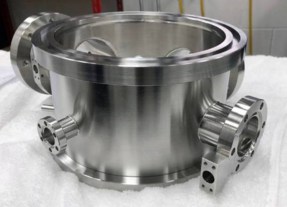What is the typical wall thickness of a vacuum chamber
In fact, there is no fixed standard value for the wall thickness of a vacuum chamber, but it is determined based on various factors.
Pressure: The pressure that a vacuum chamber can withstand is one of the important factors determining its wall thickness. In high-pressure environments, it is necessary to increase the wall thickness to meet safety and stability requirements.
Temperature: Temperature also has an impact on the wall thickness of the vacuum chamber. In high-temperature environments, in order to maintain the stability of the cavity and prevent deformation, it may be necessary to increase the wall thickness.
Materials: The strength and corrosion resistance of different materials vary, so the requirements for wall thickness will also be different. Common vacuum chamber materials include aluminum, stainless steel, titanium alloys, etc. The wall thickness of aluminum parts is generally between 0.5-5mm (but it should be noted that this is only a general range for aluminum parts and not a standard for all vacuum chambers).
Application environment and vacuum requirements: Different application environments and vacuum requirements will have different effects on wall thickness. For example, in applications that require higher vacuum levels, thicker walls may be necessary to reduce air leakage.
The shape and size of the cavity: The shape and size of the cavity also affect its wall thickness. For example, due to the special construction of cylindrical or spherical cavities, pressure dispersion is relatively uniform, and relatively thin wall thicknesses may be used; Due to the high pressure that the side flat plate needs to withstand, the square cavity may require an increase in wall thickness or the installation of reinforcement ribs to prevent deformation.
2、 General wall thickness range
Due to the influence of the above factors, the wall thickness range of the vacuum chamber is relatively wide. Generally speaking, it ranges from a few millimeters to tens of millimeters. The specific wall thickness should be determined comprehensively based on factors such as actual application scenarios, required vacuum degree, material characteristics, pressure, and temperature.
3、 Conclusion
In summary, the wall thickness of a vacuum chamber is a complex issue that needs to be determined comprehensively based on multiple factors. In practical applications, design and selection should be based on specific needs and conditions. If you need more detailed information or advice, it is recommended to consult professional vacuum technology experts or engineers in related fields.
(The article comes from the Internet. If reprinting is not allowed, please contact our company to delete it.)

